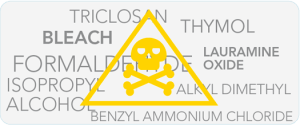Natural Does Not Mean Non Toxic: The Surprising Truth

Natural Cleaning:
Natural Does Not Mean Non Toxic:
The Surprising Truth
Fragrances are added to virtually everything from cleaning products to perfume to toothpaste and even orange juice. But fragrance isn’t just one thing, but rather a long list of ingredients that manufacturers aren’t required to disclose to the public [1]. Fragrances are used to enhance a consumer’s sensory experience of a product.
“Natural” Doesn’t Mean It’s A Non Toxic Cleaner
That’s because there are no federal regulations that dictate standards for products labeled as “natural”. In addition, manufacturers of cleaning products are not required to disclose all of their products’ ingredients on their packaging labels. This makes it very hard to know what’s hiding in your so-called “natural” cleaner, and in fact, many cleaners labeled as “natural” contain toxic fragrances, dyes, preservatives, allergens & irritants. Many of these products contain botanical-based ingredients like thymol that sound safe but that are actually known allergens.


Learn How to Sniff Out Toxic Ingredients
So what should you look for? First, look for specificity. Many manufacturers use vague terms that can hide all sorts of toxic ingredients. For example “fragrance” can actually mean a toxic cocktail of more than 100 toxic ingredients, because fragrances are considered “trade secrets”. Fragrances are linked to a shocking number of health risks. Across multiple research studies, fragrance chemicals have been classified as hormone disruptors, asthmagens, allergens, neurotoxins & carcinogens. An example are phthalates, which are the chemicals used to make scents last longer in cleaners, personal care, skin care & even baby products. Health risks for phthalates include cancer, human reproductive and developmental toxicity, endocrine disruption, birth defects & respiratory problems. These toxic villains are nearly impossible to avoid because manufacturers are not required to list them on ingredient labels. The only way to be sure you’re avoiding them is by choosing fragrance-free products. We have more bad news, which is that so-called “natural fragrances” can be just as toxic as synthetic fragrances. That’s because there is no federal safety criteria for what a “natural fragrance” is, and even natural fragrances can cause allergic reactions.
Other vague descriptions to watch for are “surfactants“ or “preservatives”, where the lack of specificity means you can’t easily research the ingredients yourself.
- Preservatives are an area you’ll definitely want to learn about, because there are several you’ll want to avoid that we go into detail on here. Methylisothiazolinone (MIT) & methylchloroisothiazolinone (CMIT) are very common in natural cleaners, and the health risks have caused their use to be restricted in Canada, the EU & Japan.
- Surfactants are another group of chemicals to watch for – these ingredients create the suds that give you the perception that a product is cleaning. You’ll want to skip sodium lauryl sulfate (SLS) given its link to skin & eye irritation, organ toxicity, reproductive toxicity, neurotoxicity, endocrine disruption & ecotoxicology. And the manufacturing of SLS & sodium laureth sulfate (SLES) lead to a highly toxic & carcinogenic by-product called 1,4 dioxane.

Botanical Doesn’t Mean It’s A Non Toxic Cleaner
When you do see specific natural or botanical ingredient, do your own research because many aren’t as safe as you think. For example, citrus and pine oil cleaners emit chemicals called terpenes that can form formaldehyde when they react with ozone in the air. Or some essential oils contain substances like eugenol and limonene which can trigger allergic reactions. An excellent resource for researching cleaning product health and environmental safety is the Environmental Working Group, which has a searchable database of products.
Remove the Guesswork
Or you can stop worrying about deciphering ingredient labels and instead try Force of Nature, which has no harmful chemicals, fragrances, dyes, preservatives, allergens or irritants. It uses electricity to convert salt, water and vinegar into a multi-purpose cleaner & disinfectant as effective as bleach. It powers through germs, grease, grime, soap scum & odors as effectively as top conventional brands but without harmful chemicals you don’t want around your children & pets. Force of Nature miniaturizes a technology from the industrial space called electrolyzed water that’s so gentle it’s used in wound healing and eye care products. Despite having no harmful chemicals, Force of Nature kills viruses & bacteria and is a federal EPA registered disinfectant registered for use in hospitals. Now that you know about the lack of regulation for “natural” cleaners, you might want to see how Force of Nature compares to typical natural cleaning products. We’ve also got the scoop about how Force of Nature is safe to use on virtually any surface in your home, and about how Force of Nature actually works.
